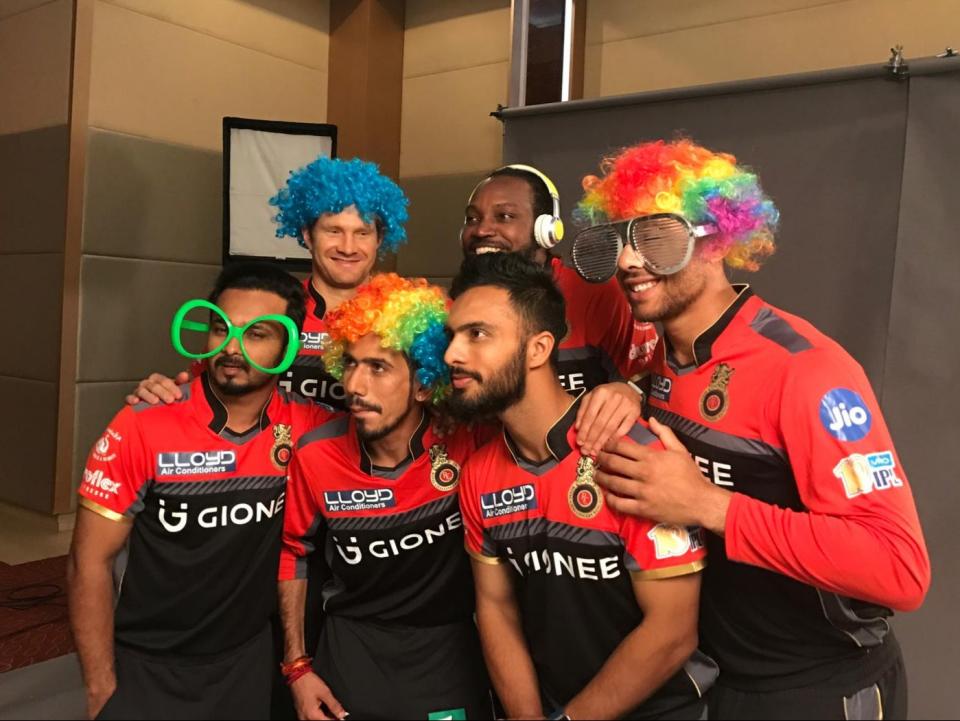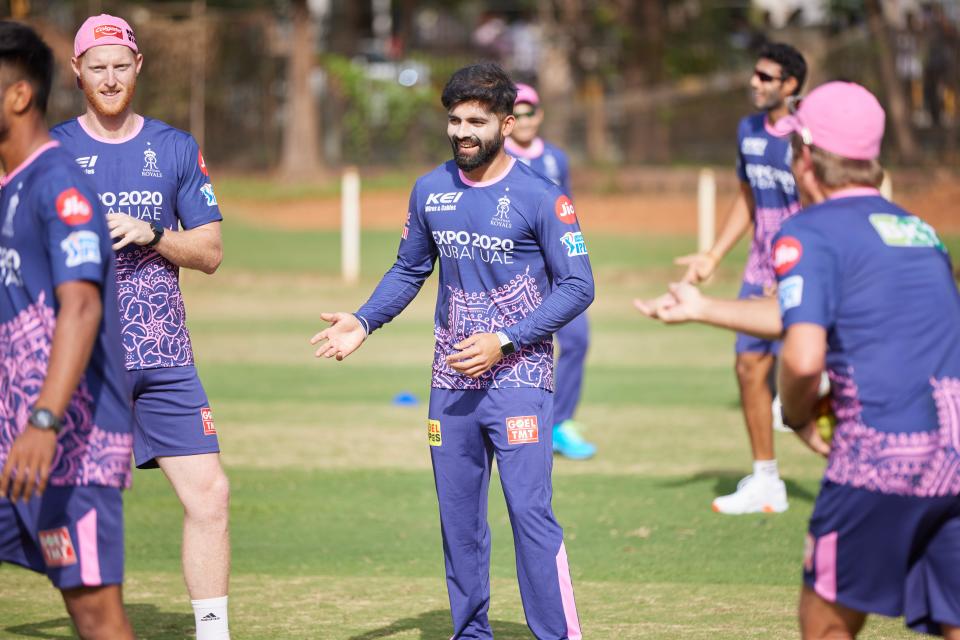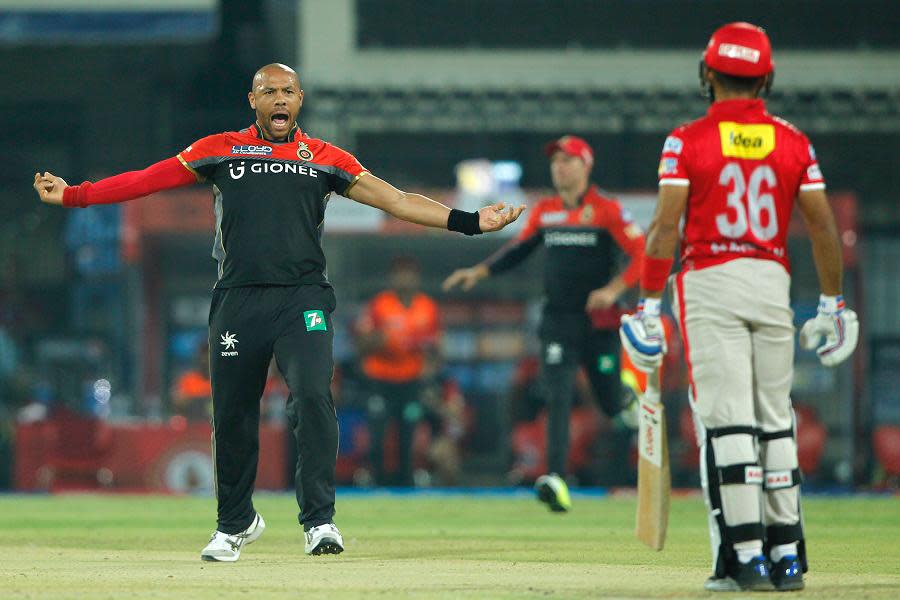IPL 2021: The graft behind the glitz and glamour of cricket’s behemoth

Tymal Mills is in bed, dressed in his full Royal Challengers Bangalore kit. The Sussex quick is asleep and dreaming of bowling. His legs kick out a few times from under him before his right arm twitches, followed by his left arm coming around to complete the action. He goes through this routine a few times before someone mercifully yells “cut”.
“When you say it out loud, it’s ridiculous,” laughs Mills. “But that went out on TV in India during the IPL. It just shows you how marketable you are for that two-month period of time and what you can get up to.”
This advert for Durolfex Mattresses was one of many sponsor engagements Mills had to undertake in the 2017 IPL season. Arriving as Bangalore’s £1.4million signing, he was pencilled in to shoot commercials, shake hands, pose for photos and partake in Q&As on almost every day of the competition, often into the early hours of the morning. The graft behind the glitz of world cricket’s foremost T20 league.
Mills embraced it, though the feeling among most overseas players is usually one of annoyance. Some avoid them completely or use excuses such as niggling injuries to be elsewhere. Others have devised ways to ensure they do not drag on.
“If you can, go with an Indian international player to one of these appearances,” one overseas player at this edition of the IPL told The Independent. “The higher profile and grumpier the better. They generally rule the roost, so if something is not being done quickly enough, they make a complaint. Suddenly a two-hour shoot can get done in 30 minutes.”
Read more:
The making of Sam Curran, a quick learner who is wasted down England’s batting order
How should England use Ben Stokes? Latest defeat leaves familiar question
The c’est la vie approach behind an England bowler in the form of his life
What we learned and what we didn’t from England’s series defeat in India
However, over the last few years, a shift has taken hold. Now more than ever before domestic and foreign players are willing to embrace the extra duties. Some even request to do more. The goal is, well, fairly obvious: to harness the untold power of a billion-strong Indian market to raise your profile and build your brand.
“I wasn’t aware of it at the time,” says Mills. “But if I was to go back to the IPL again it’s something I’d definitely tap into. I think what the smartest people have done is used their time in the IPL to expand their profiles when they’re not at the IPL. Using their fame in India 12 months of the year, not just the two they are there.”
“Around 50 or 60 per cent of my followers are in India. For my company, Pace Journal, that shoots up to 80 per cent. That’s basically your market. So, if you’re looking for a sponsor, you’re more likely to find one in India. It wasn’t something put onto me there four years ago but I’d try and maximise it.”
Perhaps the best example of this is David Warner, the blitzing opening batsman who went from Australia’s attack dog to India’s next top vlogger. Since joining Sunrisers Hyderabad in 2014, Warner has maintained a steady orange footprint across his social media channels. This went up a gear at the start of the pandemic when he amassed 4.8 million followers on TikTok through videos of him dancing to Bollywood and South Indian songs with his family.

Before TikTok was banned in India at the end of June 2020, Warner was the most viral cricketer on the app. By then, he had swelled the audience on his other platforms – 5.9m on Instagram, 2.2m on Twitter – and started a YouTube channel that recently ticked over 90,000 subscribers.
Warner might be at the extreme of embracing the IPL’s marketing platform, but he certainly was not the first. The story goes that Brett Lee’s agent sent headshots to franchises ahead of the very first edition of the tournament in 2008 to show them how valuable the Aussie quick could be on billboards to complement what they already knew of his worth on the pitch.
Putting yourself out there does not come easy, least of all to cricketers who, by and large, are a combination of introverts and creatures of habit. And it is not just the top-break of player that can harness the IPL’s transformative powers. Elevation to the next level of stardom is available to all who are savvy enough to harness it.
England’s Sam Billings is entering his fifth season of the IPL, with the Delhi Capitals this year after a stint with Chennai Super Kings and the original Delhi Daredevils where he began in 2016. Over the years, he has learned to cope with the off-field demands of the tournament and to make them work for him.
“Sometimes the extra engagements can seem like a chore,” Billings tells The Independent, “but it’s part of the IPL experience. Generally, your franchises are really good at balancing it out and looking after you.
"At times you find yourself outside of your comfort zone - I had to learn how to use kali sticks for one advert - I don’t even know why. I don’t think the footage even got used, I was shocking! But you just get it done and generally it’s not bad at all, really.”
The key, says Billings, is being courteous. Not least because difficult players who aren’t good enough to be difficult often do more damage to themselves.
“So much of franchise cricket as an overseas player is how you deal with foreign conditions: not just playing, but how respectful you are as a person. The values that are important, anyway. But sometimes that’s lacking and I do wonder if people are judged on that front by how they come across on social media. In my situation, I’m an overseas batsman, so unless you’re an AB de Villiers or a Jos, you’re not going to walk into a team. So a lot of the time you’re judged on what you do when you’re not playing and when you’re not around.”

Keeping up appearances online plays its part. Cricket’s ecosystem is small and bad perceptions can stick around, even for players who do not know they are being judged. One IPL coach, who asked to remain anonymous, noted that during a meeting a few seasons ago to choose an overseas injury replacement, a player was dismissed out of hand because he was regarded as unprofessional because he was “too boozy”. The assessment of a player, who has never graced the IPL, was made solely on his Instagram feed.
If that seems harsh then, well, tough. The IPL has never been more protective of its image and now expects that of its participants. Even from the perspective of those in charge of the performance side, there is an understanding that picking the right person is arguably more important than picking the right player.
“You’re not just packing your cricket bag and spikes when you go over there,” explains Trent Woodhill, who spent almost a decade in the competition as an analyst and batting coach with spells in Delhi and Bangalore between 2009 to 2018.
“Players now need to be very aware of their physical appearance, and very aware of their social media content. Subconsciously or not, they’ve got to go over there thinking about how they are going to tap into a billion other people.
“Cricketers by their nature are really good at dealing with distractions, and that’s probably because it is a treadmill. No one really has an off-season - they get off planes and just play.
“The best players like, say, Ben Stokes - they don’t really need it. Their skills do all the marketing for them. But if you’re below that, you need to think about what the tournament can do for you. Taking a selfie with an AB de Villiers or Virat Kohli, being caught in a chat with MS Dhoni post-match. All these things now become so relevant because the market is so huge. I think it’s hard now for players not to think about it. Not everyone makes money because they’re good players.”
Some forward-thinking franchises, like the Rajasthan Royals, have taken it upon themselves to assist players with the development of their off-field personas.
Players are offered social media training sessions every year. Before Covid, Facebook’s head of engagement would attend to talk players through how they should approach social media: when and what to post as well as the best ways to cultivate their own fanbase. That support extends throughout the year, with the Royals’ head of communications, Astha Thapliyal, working closely with players to ensure they are ticking over and prodding them if their accounts go dormant.
They also became the first IPL team to strike up a partnership with the social media platform Greenfly, a content-sharing platform used by the MLB, NBA and Neymar that allows the Royals to distribute content to players who can then use it on their various personal channels. The ease of use and accessibility encourages players to be more active.
The franchise also launched a partnership with Deakin University in Melbourne to offer sports marketing courses to their players and employees during lockdown, before offering the service to all ex-IPL players.
“It’s a point of pride at Rajasthan, that duty of care to the development of players and coaches,” says Royals’ chief operating officer Jake Lush McCrum. “For people in the IPL, they should be maximising that opportunity. You see someone like Jimmy Neesham who has built a brilliant profile for himself, but that’s pure personality. There are others who are bigger players but need a bit more guidance. Some of them are not lazy, they just don’t care or they don’t have someone pushing them to care. India’s one of the best countries in how their players engage and they all should be benefitting from it.”
One Royals success story is 19-year old batsman Riyan Parag who impressed at a trial and joined at 17, with the franchise taking responsibility for his off-field commitments to enable him to focus primarily on cricket. Through the club’s ties, Parag has become one of Red Bull’s athletes as his game progressed to a level that saw him captain his state team, Assam. Just as with Parag, McCrum makes sure he is available all year round for any queries players have over sponsorship opportunities that arise outside the IPL.
McCrum believes English cricketers are some of the worst when it comes to maintaining strong personal brands. That, partly, is down to the nature of English cricket, where agents are primarily player managers. Indian players, for example, are usually with agencies that have separate departments to help them out with side deals. But the earning potential for English cricketers has never been greater.
“Dream XI sponsor Stokes and Buttler. A few more fantasy brands are looking at English players. If a player can build their brand enough during the IPL, they will have sponsors who are wanting to join them and they are going to make a lot more money from these sponsors in India than they are from sponsors in the UK.”
If T20 has made cricket more meritocratic then the IPL has given cricketers a glimpse at just how profitable they can be as individual entities. But the riches still need to be earned, not just through consistent performance to reach and stay at that level, but indulging in the extras that open more doors along the way. Whether that’s tweeting to wish your followers a Happy Holi or, well, getting in bed and pretending to bowl in your sleep.
Perhaps, though, the biggest obstacle for those who have learned their cricket in England’s traditional confines is the cultural shift needed to give yourself to the machine of Bollywood marketing and gauche carry-on.
“In England, we’re a lot more subconscious about how we come across, how we look, what people will say,” says Mills. “And because cricket’s not the biggest sport in England, not the coolest necessarily, there is a limit to what you can do outside of your standard cookie-cutter press releases and interviews. There’s the balance between that and being too much of a try-hard.”
It is easy to dismiss a lot of this as nonsense, maybe even rallying further Against Modern Cricket. But careers are short and life is long, and getting the most out of the former offers comfort for the latter. And with sponsor appearances limited due to the stringent protocols in place for this iteration of the tournament, players will have plenty of time to fine-tune their front-facing personas. The IPL has ensured financial opportunities for cricketers great and small has never been better, even if you might have to look a bit silly once in a while.
Read More
Dustin Johnson talks up timely form ahead of Masters defence
Clouds finally part for Middlesex with better times to come
Pope will hope ‘extreme’ Indian examination helps him pass next test

 Yahoo Finance
Yahoo Finance 